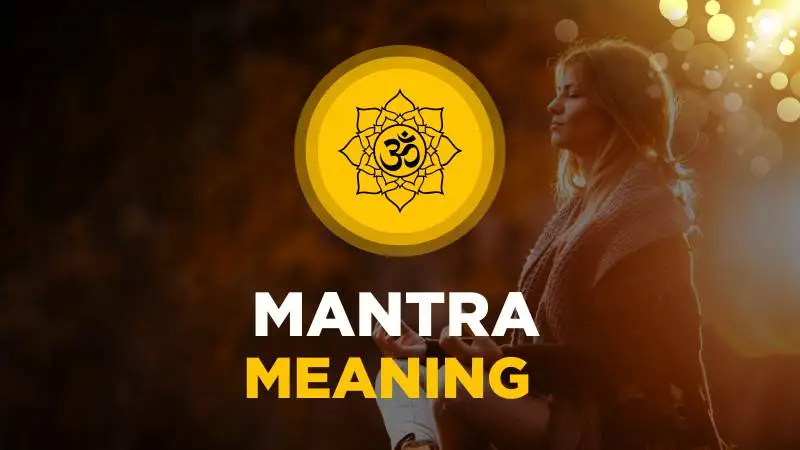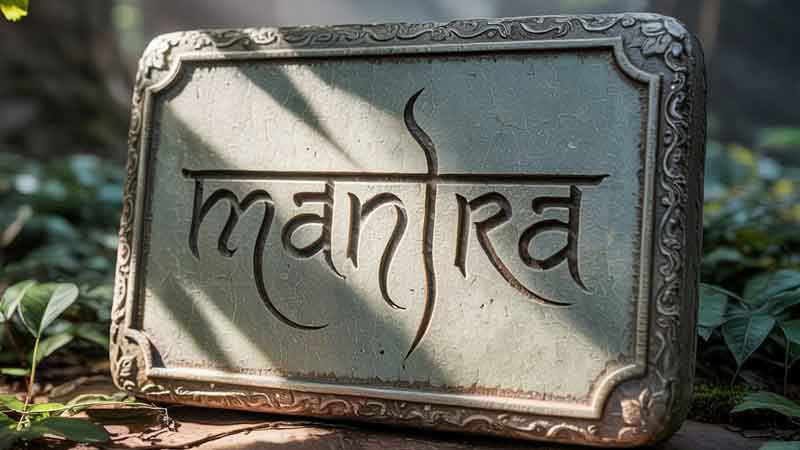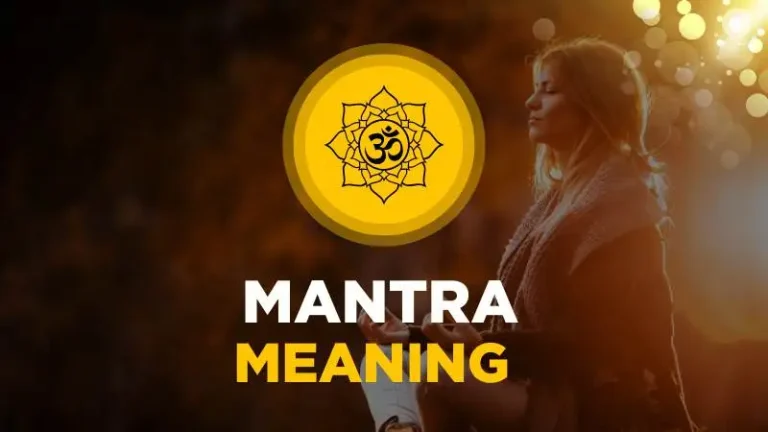
Definition of Mantra The term “mantra” refers to an individual phrase, word or sound. People usually chant or repeat it during meditation and meditation. It can also be used for self-reflection.
The term is derived in the Sanskrit word “man,” which means mind as well as “tra,” which means tool. Therefore, a mantra is an “tool for the mind” or an “instrument for thought.” Its main purpose is to assist in focusing the mind, create calm, and aid in establishing the connection to higher spiritual states.
Mantra Meaning in English
Mantras originated in the early days of India. They have been used in different religions and cultures.
These days, people are using mantras across the world to aid in meditation, mindfulness and personal motivation. Yoga classes, therapeutic methods practice, self-improvement and even daily affirmations typically incorporate mantras. To truly understand the meaning of a mantra, it is necessary be aware of its origins as well as its significance in the culture and the ways people utilize it in the present.
Manusd what is That Mantra
An mantra is a phrase, a word phrase or sound which is repeated in order to assist in meditation and spiritual practice or concentration. The word comes from the Sanskrit roots:
Spell Mantra
- “Man” = mind
- “Tra” = instrument or tool
Therefore mantras are mantra is basically an “tool for the mind” — a tool that can help you calm your mind, increase clarity and reach a higher sense of being.
What is meant by mantra
An mantra is an “tool for the mind.” It’s a phrase or sound repeated. This can help you concentrate when you meditate or do spiritual exercises.
What does the word mantra mean
A lot of people see “Montra” as a misspelling of ” mantra.” In certain instances people make use of it for names or branding, such as bicycles or even companies. But, it does not have the same meaning of meditation or spirituality.
Mantras could be:
- Sanskrit sounds like “Om”, “So Hum”, or “Om Namah Shivaya”
- Affirmations to yourself such as “I am peaceful” or “I am enough”
- Holy words employed in worship or devotional practices
They may be chanted loudly (japa) or whispered or recited silently within the mind. Different traditions (Hinduism, Buddhism, yoga, etc.) utilize mantras in various ways, however the purpose remains the same: calm the mind and to open the heart.

Historical Background and Importance of Mantras
The mantra tradition has been around for thousands of years and is primarily connected with Hinduism, Buddhism, and later Jainism. They first came into existence in the early Vedic literature of India written between 1500 to 1200 BCE. These texts are considered sacred. They make use of mantras to honor the gods, summon spiritual energy, and communicate universal truths.
The most famous songs of the modern era includes one of them, the Gayatri Mantra, a sacred phrase taken from Rigveda. Many believe it is a universal prayer seeking divine illumination, spiritual wisdom and guidance from God. The mantra in english recited Sanskrit mantra like this:
“Om bhur bhuvah svah
Tat savitur varenyam
Bhargo devasya dhimahi
Dhiyo yo nah prachodayat.”
The translation of the word is: “We reflect on the divine light of the creator who directs our intellect.”
In Buddhism and other religions the mantras play an important part in both devotional and meditation. Some of the more well-known Buddhist songs are Om Mani Padme Hum, connected to Avalokiteshvara the bodhisattva of compassion. This mantra comes from Tibetan traditions and is a symbol of the cleansing of negative energies as well as fostering compassion, love and wisdom.
Historically, people thought of mantras as not just religious instruments, but as a scientific study of the vibration and sound. The ancients believed that these mantras were a reflection of universal energies and promoted harmony in the human body and mind. In their philosophical view, they saw mantras as ways to connect the physical and spiritual realms.
The Spiritual and Cultural Importance of Mantra
Mantra meaning spiritual and cultural significance in various cultures around the world. Chants and sacred sounds generally originate directly from South Asia. However, other spiritual practices also rely on these types of chants. Examples:
- Mantras Hinduism: Hinduism believes that mantras are a way to access divine consciousness. It is believed that every mantra is a call to specific gods energy, cosmic energies, or laws. For instance, “Om” (Aum) is the most fundamental sound in the universe. Many consider it to be the most important mantra to represent the beginning of time and the existence of things.
- Mantras Buddhism: Buddhist tradition makes use of mantras as a tool to help focus the mind and create more conscious states. Tibetan monks typically sing mantras while participating in ritual activities, or when they meditate in front of sacred images. “Om Mani Padme Hum” is a sacred mantra in Buddhism.
- Meditative practices throughout the West have become popular as affirmations and motivational tools. Instead of evoking the divine the mantras are usually secular and aim to enhance your personal wellbeing. The phrases like “I am enough” or “I choose calmness” are modern interpretations of the old traditions.
In addition, mantras function as cultural icons, representing profundity and wisdom. mantra chanting, Musicians, artists and writers typically use them in music, art and literature as the timeless expressions of spirituality. The chant “Om Namah Shivaya” has been the source of many art pieces. People often chant it during modern yoga classes.
The role of Mantras in meditation and mantras as spiritual
Mantras are the mainstay of meditation. Through chanting a mantra whether in loud or silently one can focus their focus. This can help calm their mind and helps bring peace. Here’s how mantras can be employed in spiritual and meditation Today:
1. Fostering Mindfulness
The repetition of a mantra while in meditation can help focus your thoughts. Instead of letting your daily concerns take over your life, you focus your attention on the rhythm and sound of the mantra.
The chanting “Om” during meditation creates resonance. Many people say that the vibrations are relaxing and resonate with their entire being. The practice promotes concentration by keeping one’s mind focused in the present.
2. Creating Spiritual Connection
If you are a follower of faith-based practices the use of mantras is a method to connect with God’s forces. Chanting sacred mantras like “Hare Krishna” in Hinduism or “Namo Amitabha Buddha” in Buddhism conveys devotion through sound.
3. Healing and Energy Balance
Many believe that every mantra is a unique sound that help the mind and body. Many consider that particular mantras help balance chakras or energy centers that are located within the body. Many believe that chanting helps align these chakras and enhances physical and emotional well-being.
4. Developing Discipline
Mantras require discipline as well to repeat them consistently. A lot of practitioners employ mala beads to track the number of times they have recited in completing a specific number of mantras (often at least 108). This exercise builds self-control and helps to promote a peaceful lifestyle.
Even in the absence of traditional spiritual practices, people make use of mantras to boost concentration. Sportsmen may repeat motivational words to remain focused. CEOs can use affirmations to keep them in a state of calm and make informed choices.
Modern Applications of Mantras
Mantras have changed significantly and are now a part of the modern wellness and self-care routines. They’re not just used for religious occasions. Today, people are using these to lessen anxiety, boost confidence and boost confidence all the time. Here are some of the modern methods of applying mantras today:
1. Stress Reduction
Repetition of a mantra, like “peace,” “calm,” or “be here now,” can help ease tension. This method uses repetitive repetition in order to establish a calm rhythm. It lowers cortisol levels, and also promotes relaxation.
2. Inspiring confidence through affirmations
Many people use mantras for affirmations to shift their thinking. Examples of motivational phrases include:
- “I am strong and capable.”
- “I attract abundance into my life.”
- “I release what no longer serves me.”
These affirmations will alter your thoughts in some time. It can help replace negative thoughts with positive perspectives.
3. Therapeutic Tools
Mantras are frequently used in mental health treatments. Meditation with mantras that are mindful helps reduce the symptoms of depression and anxiety. Through cognitive behavioral therapy (CBT) individuals make use of simple phrases to stimulate their brains more positively.
4. Yoga and Fitness
The inclusion of mantras in yoga routines has gained recognition. Chanting during yoga practice helps improve focus. It helps to make the experience more enjoyable because it combines physical, mental and spiritual components in one.
A lot of yoga classes begin or end by “Om” chanting. This assists in connecting the student in the universe of consciousness.
5. Personalized Mantras for Goal-Setting
Motivational and life coaches frequently stress the importance of designing personal mantras that are tailored to each person’s goals. Example:
- “I will achieve my dreams.”
- “Every small step matters.”
These mantras are powerful reminders of your personal goals that keep people focused and resilient.
6. Professional and work environments
The workplace, stress-inducing phrases are frequently used to increase the effectiveness and concentration of employees. Certain phrases, such as “be present” or “success starts here” aid professionals to remain focused and focusing in their busy schedules.
Modern science has proved the traditional method. Studies on mindfulness meditation have revealed tangible benefits for the brain, emotional regulation as well as anxiety reduction which proves the importance of mantras in the present.
Mantra Benefits
The benefits of using mantras are varied and impact both the body and mind. Let’s examine the details of their positive effects.
It is the Mindful Practice of Presence: Mantras anchor your thoughts and help you focus your attention away from distractions, while keeping your attention on the present.
The Chanting of Stress Relief: Chanting mantras could induce relaxation and reduce heart rate, as well as relieving tension in muscles.
Whatever their meaning or design Whatever their purpose, the use of mantras can enhance the spiritual aspect of life and everyday life.
Final Thoughts on the Power of Mantras
The simplicity of mantras is what shows their beauty. They don’t require elaborate rituals or special skills to gain the benefits of their ability. If you’re looking for the development of your spirituality and clarity of mind or emotional healing, you have the opportunity to benefit. All you require is a word, sound or phrase that resonates with you, and a promise to keep it in mind consistently.
You can repeat mantras at the holy site or softly whisper them during an incredibly busy commute. They help us remember the power of words and sound. Mantras can help you relax your mind, and help connect with our souls, and help to create peace in our busy lives.




